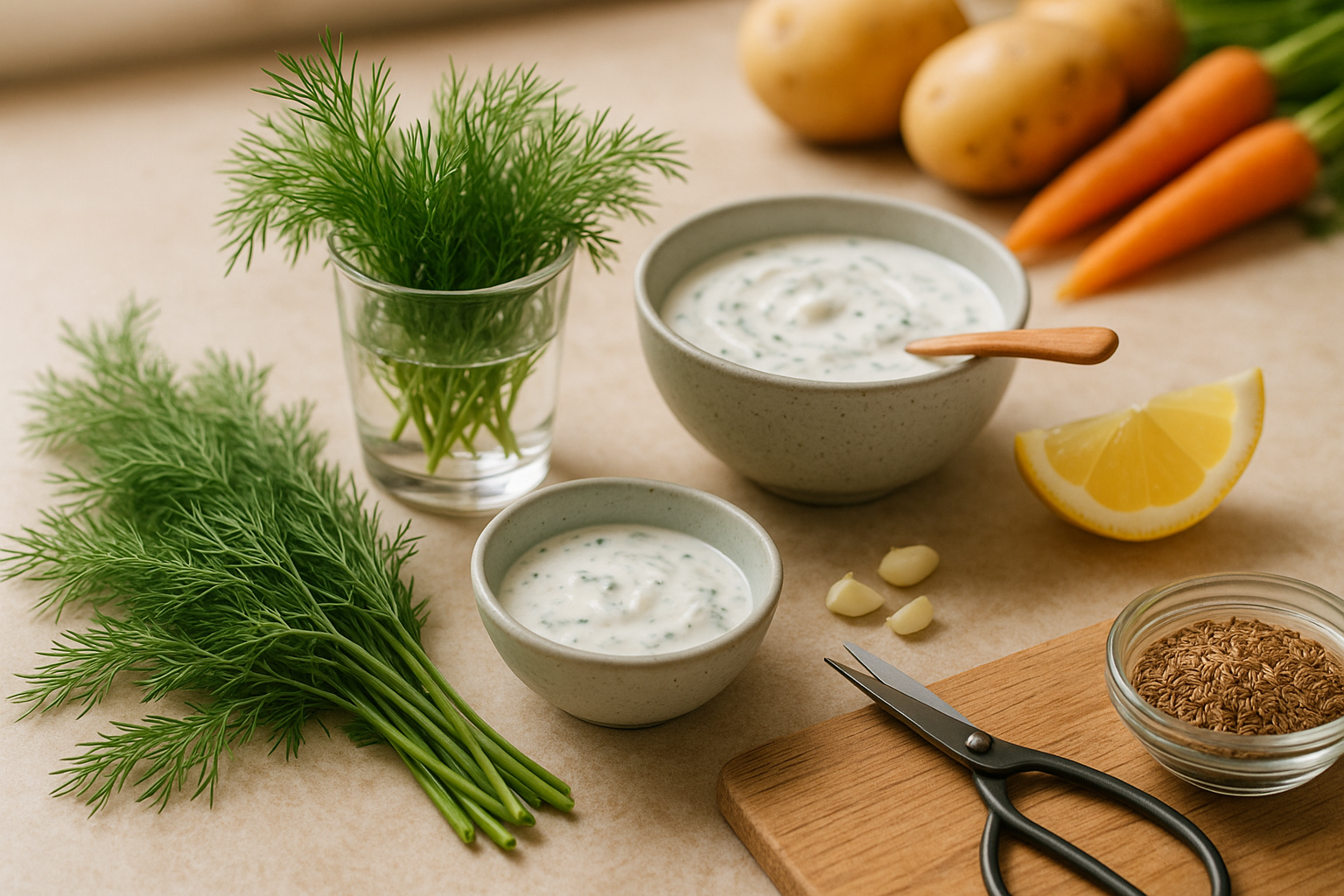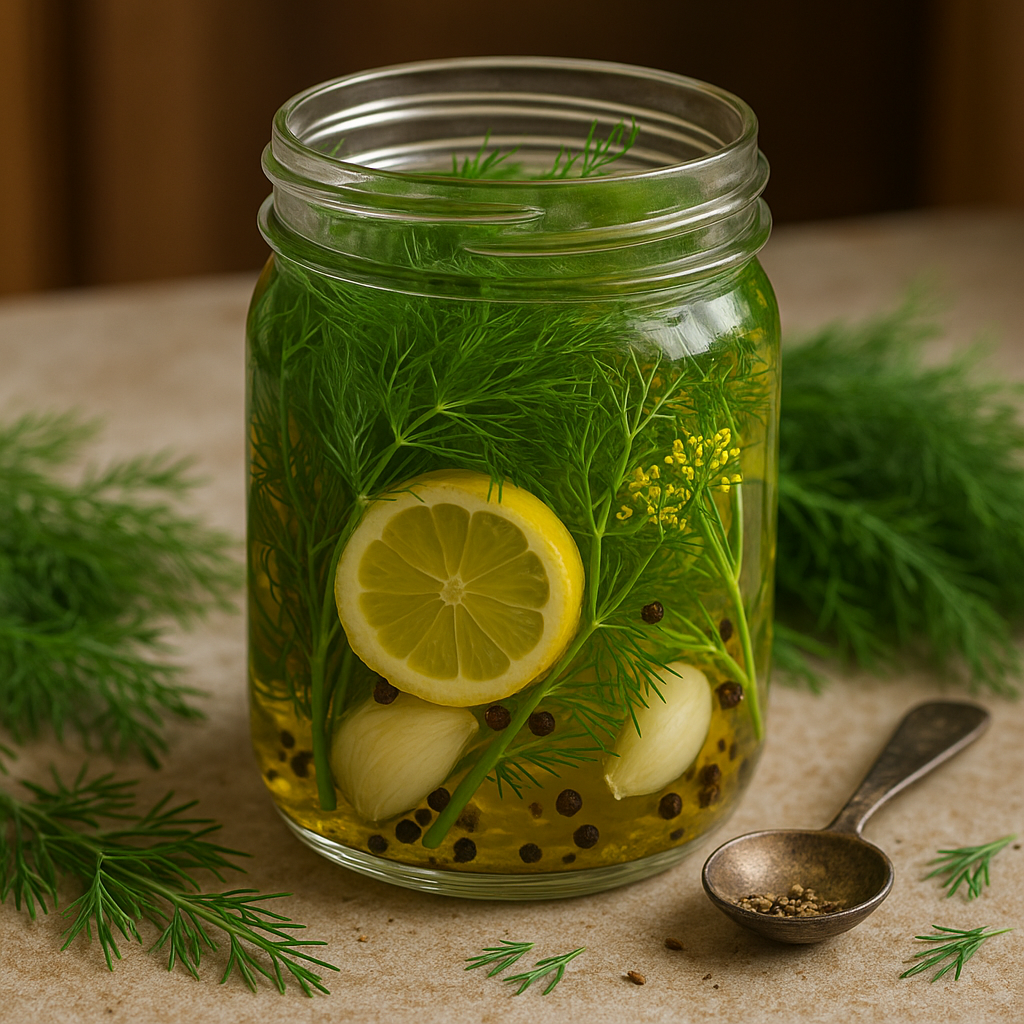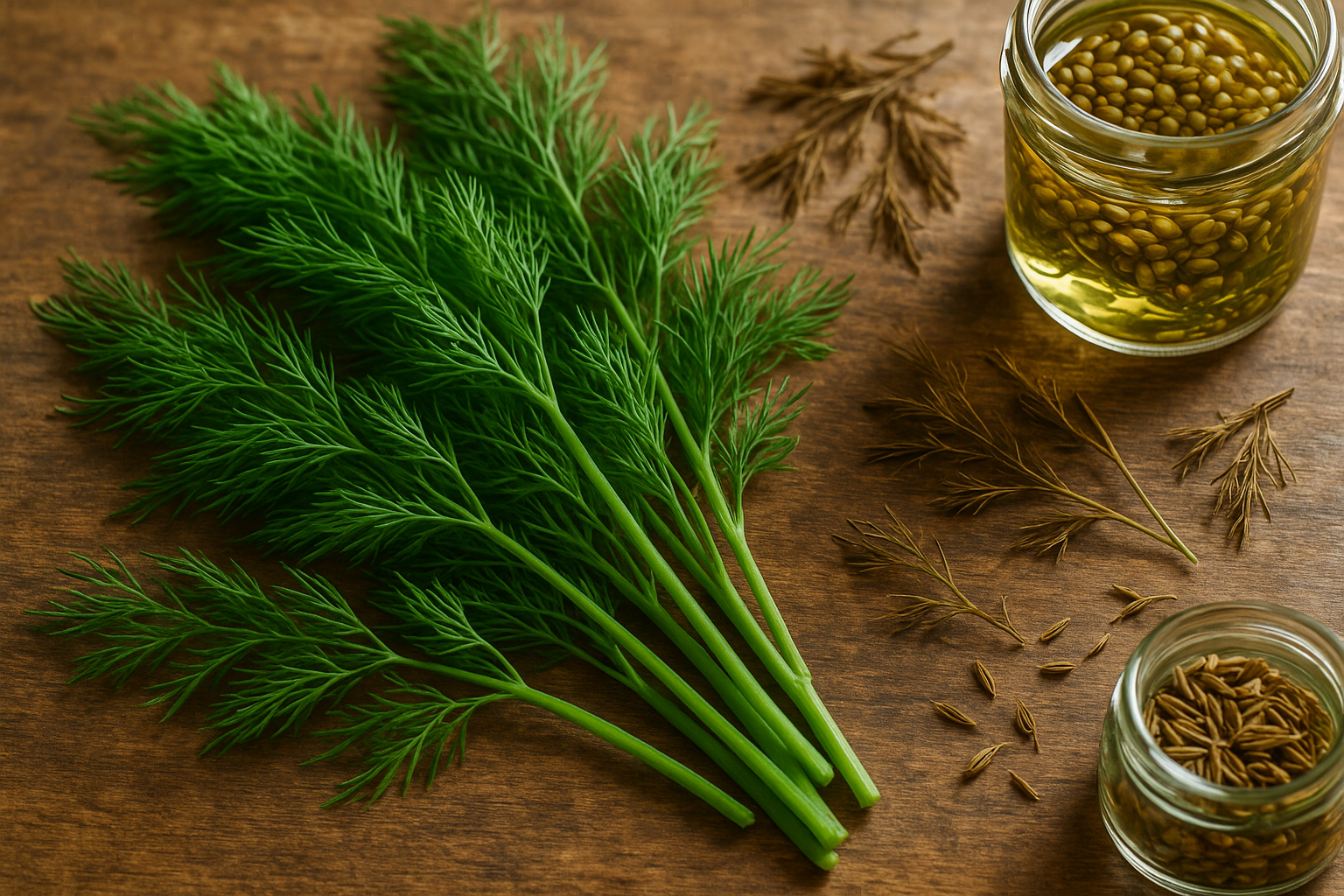Introduction to Dill
Cooking with dill opens up a world of fresh, tangy flavors that have inspired cooks for centuries. This versatile herb, scientifically known as Anethum graveolens, belongs to the celery family and is native to southern Russia, western Africa, and the Mediterranean region. With its delicate feathery fronds and wispy seeds, dill offers a unique taste—fresh, grassy, with anise-like notes and just a hint of lemon.
These vibrant flavors make dill a staple in cuisines ranging from Scandinavian and Eastern European to Middle Eastern and Indian kitchens. When cooking with dill, you’ll find it available in three main forms:
- Fresh fronds — great for garnishing salads or fish
- Dried leaves — perfect for blending into dips or dressings
- Pickled seeds — often used in tangy vinaigrettes or as a zesty boost in homemade pickles
Each form of dill offers a slightly different flavor intensity and purpose, giving you room to experiment across dishes. For example, a sprig of fresh dill can add brightness to roasted potatoes, while a teaspoon of dried dill is ideal for whipping up a classic Greek tzatziki sauce. Pickled dill is the secret behind the punchy flavor of a good dill pickle.
Whether you’re seasoning creamy potato salad, infusing flavor into bread, or perking up a cool yogurt sauce, dill’s possibilities are almost endless.
Fresh Dill in the Kitchen

Bright green and feathery, fresh dill brings an inviting burst of life to any kitchen. Its delicate fronds look almost fern-like, and when you rub them between your fingers, they release a crisp, grassy aroma with hints of anise and lemon. Flavor-wise, dill is light and tangy, with a subtle sweetness that stands out without overpowering other ingredients.
It’s a staple in European and Mediterranean cooking, where its fresh flavor pairs famously with fish—think classic Scandinavian gravlax or Greek tzatziki dip. For a simple salad, toss chopped dill into new potatoes with a drizzle of olive oil, lemon juice, and cracked pepper; its bright notes elevate even the plainest vegetables.
Dill is also a secret weapon in dressings: blend it with yogurt, garlic, a squeeze of lemon, and salt for a quick, creamy dip or drizzle. Another easy use is folding it into scrambled eggs, adding color and flavor in seconds, or sprinkling it over roasted carrots or salmon for a fresh twist.
Fresh dill can be stored wrapped loosely in damp paper towels inside a resealable bag in your fridge, where it will stay vibrant for around five days. If you won’t use it that quickly, stand the stems in a glass of water like a bouquet and cover loosely with plastic. For longer storage, finely chop and freeze dill in ice cube trays with a bit of olive oil, making it easy to pop a cube into soups or sauces whenever you need a punch of flavor.
With its shimmering green color, aromatic freshness, and versatile taste, fresh dill is a humble but transformative herb every home cook should keep handy.
Dried Dill
Dried dill is a surprisingly powerful pantry staple, often stronger and more concentrated in flavor than its fresh counterpart. While fresh dill has a light, grassy taste and delicate texture perfect for garnishing salads, potatoes, or fish dishes just before serving, dried dill offers a deeper, more intense herbaceous note that shines in heartier applications.
It’s ideal for seasoning creamy soups, homemade ranch dressings, potato salads, and dry spice blends—any dish that benefits from a burst of green flavor but doesn’t require the subtle crunch of fresh sprigs.
When swapping dried dill for fresh, remember that dried herbs pack more flavor into a smaller volume; use one teaspoon of dried dill in place of one tablespoon of chopped fresh dill for best results.
To keep dried dill at its most potent, store it in an airtight jar away from heat and direct sunlight—think a dark cupboard rather than a shelf above the stove. If possible, buy in small quantities and replace every six months, since dried dill loses its punch faster than other herbs.
For weekday cooking, keeping dried dill within arm’s reach can add complexity to egg dishes, yogurt dips, or even roasted vegetables, especially in the colder months when fresh dill isn’t always at hand. With the right storage and simple substitution, you’ll find dried dill is a low-effort upgrade with a flavorful payoff that lasts all year.
Pickled Dill

Pickling dill transforms its flavor profile, making it sharper, tangier, and more intense than fresh dill’s subtle grassy aroma. When steeped in vinegar, salt, and spices, dill’s bright, lemony notes deepen, giving it a punch that can elevate dishes well beyond traditional pickles.
Classic uses of pickled dill shine in Eastern European potato salads, egg salads, and, of course, atop smoked salmon or in a deli-style sandwich—think pastrami or turkey, where the floral zing of dill balances rich meats. But don’t stop there!
Try adding chopped pickled dill to homemade tartar sauce, folding it into creamy dips, or sprinkling it over roasted vegetables for an unexpected twist.
How to Make Pickled Dill at Home
Making pickled dill at home is surprisingly simple:
- Fill a clean jar with washed fresh dill sprigs.
- Add sliced garlic, a teaspoon of black peppercorns, and a few lemon slices.
- Boil a cup of white vinegar with a cup of water and a tablespoon of salt.
- Pour this mixture over the dill until submerged.
- Cool, seal, and refrigerate—the flavors will intensify after just a day or two.
Using Pickled Dill
For a quick meal boost, layer pickled dill in a chicken wrap, toss it into a potato and radish salad, or use it as a garnish for grilled fish. The possibilities go far beyond the classic pickle jar, bringing fresh brightness and zing to countless everyday meals.
Perfect Pairings
Dill’s feathery leaves and fresh, tangy flavor make it a natural companion to a surprising range of foods and seasonings. Classic pairings put dill side-by-side with potatoes, salmon, cucumbers, and eggs; a handful of chopped dill can elevate simple roasted potatoes or creamy egg salad sandwiches.
Its peppery brightness also balances rich dairy, so try stirring it through Greek yogurt for a homemade tzatziki or sprinkling it atop buttered corn. In Eastern European cuisine, dill stars in borscht, cold beet salads, and tangy pickles, while in Scandinavia, it’s a signature accent for cured fish and creamy sauces. Middle Eastern dishes use dill alongside mint, parsley, and citrus—think herby rice pilafs or dill-flecked yogurt dips for grilled meats.
To start experimenting at home, try these ideas:
- Toss dill with lemon juice, olive oil, and garlic to make a quick dressing for summer salads.
- Mix it into softened butter and spread on crusty bread.
- Add it at the end of cooking mild white fish for a burst of flavor.
For adventurous cooks, blend dill with basil or tarragon in green sauces, or chop it with fennel fronds for herbal brightness in dips. Remember: dill’s delicate taste can fade if cooked too long, so add it last to hot dishes.
Whether you’re looking to freshen up chicken salad, lend a twist to classic hummus, or bring out the flavor in pickled veggies, dill is a simple, delicious way to experiment with new combinations in your kitchen.
Smart Storage and Kitchen Tips
Storing dill correctly helps you get the most flavor, whether you use it fresh, dried, or pickled.
For fresh dill, loosely wrap the stems in a slightly damp paper towel and tuck them into a resealable bag in the fridge—they’ll stay fresh for up to a week. Alternatively, place the stems upright in a glass of water, cover with a plastic bag, and refrigerate.
Dried dill should be stored in an airtight jar in a cool, dark place to protect it from moisture and light; this way, it keeps its flavor for up to six months.
Pickled dill, often used for canning, needs to be stored in a tightly sealed container in the fridge after opening.
Keep an eye out for limp leaves, yellowing, or a musty smell—these are signs your dill is past its prime. Dried dill that’s lost its strong, grassy aroma is no longer potent.
If you love having fresh dill on hand, it’s easy to grow at home in pots or garden beds with full sun and good drainage. Make successive plantings every few weeks for a steady supply.
Watch for caterpillars, poor sprouting, or wilting—these are common issues. Removing pests by hand, not overwatering, and thinning crowded seedlings can solve most problems quickly.
Creative Recipes and Inspiration
Dill is an amazing herb that transforms more than just pickles—its bright, grassy flavor adds personality to a surprising range of dishes. With fresh dill fronds, try tossing them into a simple yogurt sauce with lemon and garlic to drizzle over roast veggies or fish, or fold them into scrambled eggs for a burst of herbal freshness. Chopped fresh dill is also a game-changer in potato salads and homemade dressings.
Dill seeds, meanwhile, carry a slightly caraway-like flavor—sprinkle them into bread dough, use them in a rye loaf, or crush them with salt, pepper, and garlic powder as a rub for roasted meats or carrots. Dried dill works beautifully in spice blends; stir it into soups, stews, and creamy dips, or quickly revive it with olive oil for an instant herb topping on popcorn or pasta.
Don’t overlook the stems and flowers, which infuse subtle flavor into vinegars, oils, or even a classic chicken soup. To really get creative, try adding dill fronds to compound butter for grilled corn, blending dill seeds into a zesty marinade for beets, or using dried dill in homemade ranch popcorn seasoning.
Dill works in simple weeknight meals—mix it into slaws, sprinkle it on roasted potatoes, or stir it into cottage cheese for a snack. With endless ways to use both the fresh and dried forms, dill is your shortcut to eye-opening, unique flavors at home. Explore beyond the usual, and you’ll find this herb effortlessly upgrades everyday cooking, proving just how versatile and modern-friendly dill can be.
